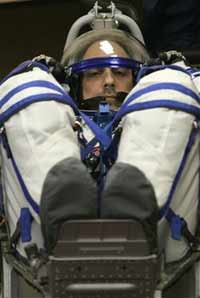Astronauts on board ISS forced to wee in space again
The toilet on board the International Space Station has come out of order again, Fox News reports with reference to John Petty, an official spokesman for NASA. Supposedly, the problem occurred in the gas separator of the basic lavatory in the Russian part of the station. The incident occurred only several hours before Soyuz TMA-13 with three new members of the crew was to dock the ISS.

Russian specialists are figuring out the reason of the mishap. However, they have already received instructions to use the reserve toilet of limited capacity, which is located on board the Soyuz booster rocket.
A source from the Russian space industry told Interfax on conditions of anonymity that the toilet was indeed functioning improperly on board the ISS on Monday. It was also said that the problem had already been solved.
The space toilet on board the station is a complicated complex that uses a system of fans to process human wastes for their subsequent utilization. Water is not used in the process at all.
A similar incident occurred on the station in June. The space toilet was repaired only when the new pump was delivered to the ISS.
Shuttle Endeavour will deliver a toilet of the new construction to the station in November. It will be installed in the American sector of the station. NASA purchased the toilet designed by Russian specialists for 19 million dollars.
The toilet on the International Space Station located in the Zvezda module uses a fan-driven suction system similar to the Space Shuttle WCS. Liquid waste is collected in 20 liter containers. Solid waste is collected in individual micro-perforated bags which are stored in an aluminum container. Full containers are transferred to Progress for disposal. An additional Waste and Hygiene Compartment is scheduled be part of the Node 3 module to be launched in 2010.
On May 21, 2008, the 7-year-old toilet's gas liquid separator pump failed, although the solid waste portion is still functioning. The crew attempted replacing various parts, but was unable to repair the malfunctioning part. In the interim, they used a manual mode for urine collection. The crew has other options: use the toilet on the Soyuz transport module (which only has capacity for a few days of use) or to use urine collection bags as needed. A replacement pump was sent from Russia in a diplomatic pouch so that Space Shuttle Discovery could bring it to the station as part of mission STS-124 on June 2nd.
While the Soyuz spacecraft had an onboard toilet facility since its introduction in 1967 (due to the additional space in the Orbital Module), all Gemini and Apollo spacecraft required astronauts to urinate in a so-called "relief tube," in which the contents were dumped into space (an example would be the urine dump seen in the movie Apollo 13), while fecal matter were collected in specially-designed bags known as "Apollo Bags," which were a bane by all crew members. The Skylab space station, used by NASA between May, 1973 and March, 1974, had an onboard WCS facility which served as a prototype for the Shuttle's WCS, but also featured an onboard shower facility.
Even with the facilities, astronauts and cosmonauts for both launch systems employ pre-launch bowel clearing and low-residue diets to minimize the need for defecation. The Soyuz toilet has been used on a return mission from Mir.
NPP Zvezda is a Russian developer of space equipment, which includes zero gravity toilets (Assenisation Sanity Unit ASU-8A). The recently (2008) failed unit abroad the ISS was of this type.
Subscribe to Pravda.Ru Telegram channel, Facebook, RSS!





